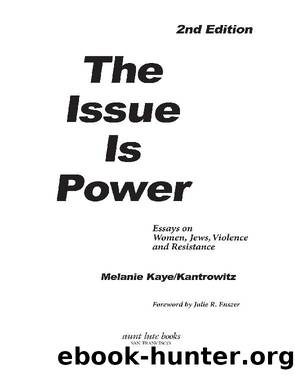The Issue is Power by Melanie Kaye Kantrowitz

Author:Melanie Kaye Kantrowitz
Language: eng
Format: epub
Publisher: Aunt Lute Books
NOTES
I want to thank Lisa Weissbach, Ehrai Adams, and others at Oberlin College, for discussion of some of these issues and for their openness and thoughtful responses. More recently, Iâm indebted to Jayna Brown, Lisa Hall, and Chris Lymbertos for challenging editorial suggestions. Responsibility for the opinions and analysis is mine alone.
1. Tim Rutten in The New York Review, June 11, 1992.
2. Henry Louis Gates Jr., summarizing a popular Afrocentric text which stigmatizes Jews as particularly racist, Michael Bradleyâs The Iceman Inheritance: Prehistoric Sources of Western Manâs Racism, Sexism, and Aggression; in âBlack Demagogues, and Pseudo-Scholars,â NY Times, Op-Ed page, July 20, 1992.
3. It bears repeating that most Jews from the Middle East, India, Latin America, Turkey, Ethiopia and elswhere are, by definition, people of color. Of course many Ashkenazi Jews are also dark-skinned.
In the 1988 election, among the less than half of those eligible to vote, who bothered to do so, Blacks led in voting progressive; Hispanics second and Jews third. About two-thirds of Jews chose the Democrats, voting in many cases against their economic self-interest. While Blacks have replaced Jews as predictably progressive leaders (see, for example, the voting record of the Congressional Black Caucus), Jews have not turned conservative at the same rate as their immigrant cohorts.
4. Gates (note 2) mentions the Nation of Islamâs publication The Secret Relationship between Blacks and Jews, which distorts historical fact to charge the Jews with primary responsibility for the crime of slavery. Gerald Sorin, Director of Jewish Studies and Professor of American History at SUNY New Paltz, made a similar point in his presentation on the minor role of Jews in the slave trade at a forum organized by Jews for Racial and Economic Justice in New York City, Jews and Slavery: Participation and Resistance, April 8, 1992.
5. Grace Paley, âNow and Then,â Tikkun (May/June 1989), p. 76. In particular, European medieval and Renaissance history from a Jewish perspective reads like a disaster chronicle: expelled from here, massacred there, forced conversions someplace else. Occasionally there is a bright spot: âJews return to Wormsâ (from which they had been expelled the year before). âJews allowed to settle in Englandâ (from which they had been expelled some centuries earlier). The late nineteenth-early twentieth century, especially in Eastern Europe, presents a similar wave of persecution, dwarfed only by the magnitude of what followed. Grievous official and unofficial oppression of Jews was a common feature of modern pre-Holocaust Europe.
6. For a fuller discussion of these issues, see âTo Be a Radical Jew.â¦â
7. Jews who could pass as gentile, because they looked less Jewish and could speak the dominant language fluently, were more likely to survive the various swings of anti-Semitism. Thus to tell some survivors of the European Holocaust who may have survived by passing âyou donât look Jewishâ is to twist a painful truth; had the person looked more Jewish, s/he would probably be dead.
8. I do not mean to claim a new and special status of victimization of uncertainty, which may even
Download
This site does not store any files on its server. We only index and link to content provided by other sites. Please contact the content providers to delete copyright contents if any and email us, we'll remove relevant links or contents immediately.
Twisted Games: A Forbidden Royal Bodyguard Romance by Ana Huang(3840)
Den of Vipers by K.A Knight(2639)
The Push by Ashley Audrain(2632)
Win by Harlan Coben(2605)
Echo by Seven Rue(2186)
Beautiful World, Where Are You: A Novel by Sally Rooney(2105)
Leave the World Behind by Rumaan Alam(2055)
Iron Widow by Xiran Jay Zhao(2054)
Baby Bird by Seven Rue(2051)
Midnight Mass by Sierra Simone(1960)
A Little Life: A Novel by Hanya Yanagihara(1924)
Undercover Threat by Sharon Dunn(1744)
Bridgertons 2.5: The Viscount Who Loved Me [Epilogue] by Julia Quinn(1730)
The Four Winds by Hannah Kristin(1725)
The Warrior's Princess Prize by Carol Townend(1596)
Sister Fidelma 07 - The Monk Who Vanished by Peter Tremayne(1587)
Snowflakes by Ruth Ware(1552)
Facing the Mountain by Daniel James Brown(1503)
Dark Deception by Rina Kent(1502)
